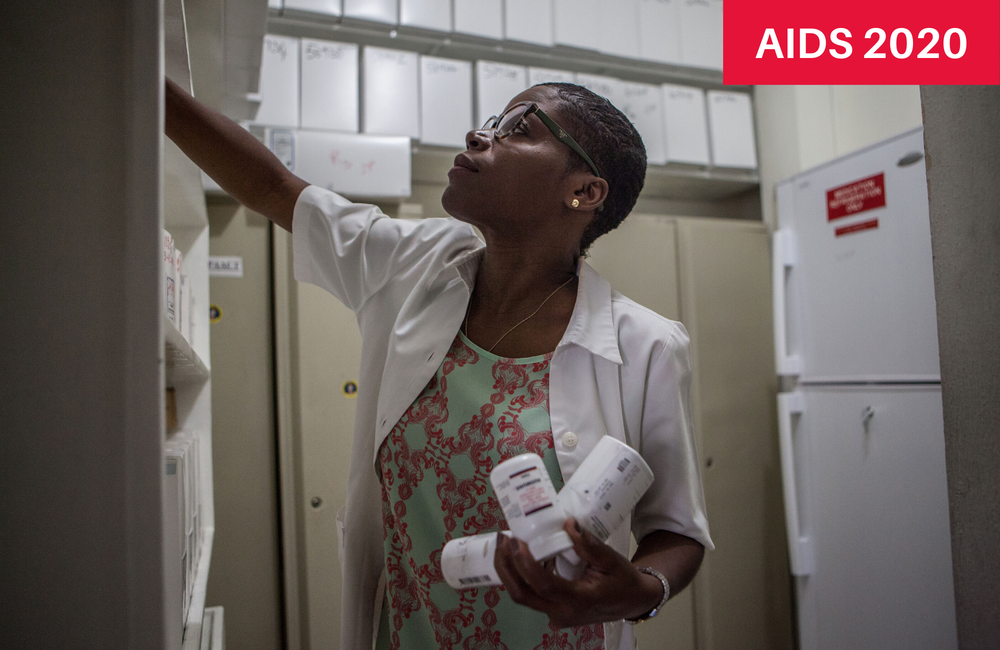
Retaining tenofovir after the failure of first-line treatment rather than replacing it with zidovudine was associated with better retention in care, better adherence and better viral load suppression in people with HIV in Haiti, especially when combined with atazanavir/ritonavir, Dr Samuel of GHESKIO in Port au Prince reported to the 23rd International AIDS Conference (AIDS 2020: Virtual) this week.
World Health Organization guidelines recommend the use of tenofovir disoproxil fumarate (TDF) in first-line treatment in resource-limited settings. If first-line treatment fails, the guidelines recommend switching from tenofovir to zidovudine, but there are concerns that twice-daily dosing of zidovudine may cause adherence difficulties. The side effects of zidovudine, including nausea, anaemia and limb fat loss, also make it an unattractive option for second-line treatment.
An alternative second-line option is to recycle tenofovir as part of a new combination, based on limited evidence that recycling the drug contributes to viral suppression despite the presence of the K65R mutation.
A meta-analysis of studies of drug resistance after first-line failure showed that more than half of people taking the drug developed tenofovir resistance after failure of their first-line regimen in sub-Saharan Africa and people with subtype C HIV were at higher risk of developing resistance.
Resistance testing in Haiti’s GHESKIO HIV clinic shows that 30% of people on failing first-line treatment have the K65R resistance mutation associated with resistance to tenofovir.
To assess the impact of retaining tenofovir in second-line treatment, researchers carried out a retrospective review of all adults who experienced failure of a first-line regimen of tenofovir/lamivudine/efavirenz and who switched to second-line treatment containing either tenofovir/lamivudine or zidovudine/lamivudine.
They assessed retention in care within 12 months of switching, adherence based on pharmacy refill data and viral suppression below 200 copies/ml. They also assessed outcomes according to the other second-line agent (either lopinavir/ritonavir or atazanavir/ritonavir).
A total of 1017 people switched to a second-line regimen; of these, 284 switched to zidovudine while 733 retained tenofovir.
The cohort had a mean age of 42 years. A higher proportion of people experiencing first-line failure switched to zidovudine in the period 2012-2015 (120 out of 300 switchers) than in the period 2016-2018 (164 out of 717 switchers) but the higher volume of switching in the later period means that the majority of people who switched to zidovudine did so in the 2016-2018 period (57%, p < 0.001).
Retention in care did not differ between switchers and non-switchers at 12 months after switching (83% in each group).
Non-switchers were significantly more likely to have a viral load below 200 copies/ml on their first viral load test carried out more than 12 months after switching, but only half of this group has an undetectable viral load at this point (52% vs 38%, p < 0.001). Non-switchers also had significantly better adherence; 48% had adherence of 90% or greater compared to 38% of switchers (p = 0.006).
Multivariable analysis showed that non-switchers had a higher likelihood of 12-month adherence greater than 90% (odds ratio 1.53 [1.11-2.11]) and of a first viral load test below 200 copies/ml (OR 2.08 [1.46-3.38]). Non-switchers with adherence below 90% had a higher likelihood of a first viral load below 200 copies/ml (OR 2.05 [1.21-3.48]. If tenofovir-based treatment combined with a boosted protease inhibitor is more likely to maintain viral suppression despite poor adherence, this may be a consequence of the long half-life of the drug, which might maintain viral suppression when boosted protease inhibitor levels fall.
Further analysis of outcomes according to the second-line boosted protease inhibitor showed that non-switchers taking once-daily atazanavir were significantly more likely than switchers to be retained in care after 12 months, to have 12-month adherence greater than 90%, to have a first viral load test below 200 copies/ml and for people with 12-month adherence less than 90% to have a first viral load test below 200 copies/ml.
In contrast, non-switchers taking twice-daily lopinavir/ritonavir were significantly less likely to be retained in care than switchers (OR 0.65 [0.43-0.98]) and did not have better adherence. But non-switchers were significantly more likely to have a first viral load below 200 copies/ml (OR 1.95 [1.32-2.90] and to have a first viral load below 200 copies/ml if they had greater than 90% adherence (OR 2.76 [1.40-5.43]).
"Treatment toxicity and pill burden should be taken into consideration when selecting a treatment regimen after first-line failure," Pierre concluded.
Pierre S et al. Sub-optimal outcomes with switching to zidovudine vs. recycling tenofovir in second-line treatment in Haiti. 23rd International AIDS Conference, abstract OAB0405, 2020.
